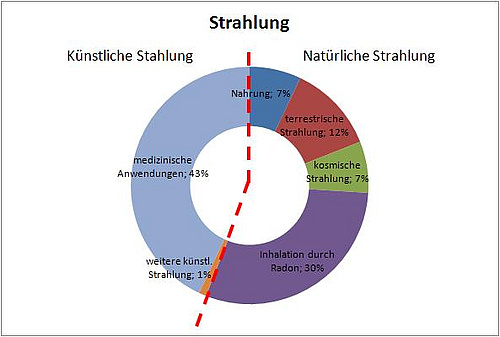Natural Radiation Can Be Measured with geiger counter RadRate Basic

- inhalation of radon (approx. 1.3 mSv/a)
The inhalation of the radioactive noble gas accounts for over 50% of the natural radioactive exposure to humans in Germany. - exposure by food intake (approx. 0.3 mSv/a)
All foods contain substances with radioactive elements. - terrestrial radiation (approx. 0.5 mSv/a)
The terrestrial radiation stem from the natural radionuclides contained in the ground and in rocks. These are vastly different from region to region. - cosmic radiation (approx. 0.3 mSv/a)
Earth is constantly exposed to a stream of high-energy atomic particles (mostly protons) from outer space. These particles react with atmospheric elements, forming new atomic particles. The aggregate of these particles constitute the so-called cosmic radiation. On its path to the earth surface, the cosmic radiation weakens through the increased density of the atmosphere.
Artificial Radiation Can Be Measured with geiger counter RadRate Basic
- other artificial radiation (< 0.1 mSv/a)
fall-out from testing nuclear weapons (< 0.1 mSv/a)
nuclear technical plants (< 0.1 mSv/a)
radiation exposure in the work environment (< 0.1 mSv/a)
aftereffects of the nuclear accident at Chernobyl (1985) (approx. 0.2 mSv). - radiological materials and ionizing radiation in medical applications (approx. 1.8 mSv).
Even shortly before discovering roentgen rays (X-rays) in 1895, radiation had been utilized for medical diagnostic purposes. Since then, the extent of the applications has increased considerably. The development of computerized chemotherapy (CT) has generated yet more specific information. In particular cases of medical diagnostics, patients are injected with radionuclides (nuclear medicine). Much higher doses than for diagnostic purposes are administered in radiation therapies for cancer treatment. X-rays can also be detected with the geiger counter RadRate Basic.
